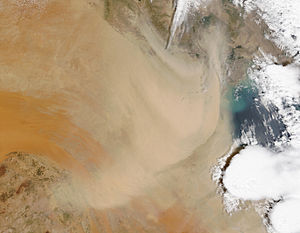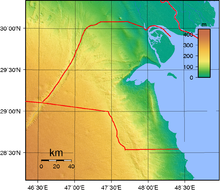- Geography of Kuwait
-
 Satellite image of Kuwait
Satellite image of Kuwait
Kuwait is situated in Southwest Asia, bordering the Persian Gulf, between Iraq and Saudi Arabia. Once a small Persian Gulf sheikhdom known locally as a center for pearl diving and boat construction, Kuwait came to international prominence in the post-World War II era largely because of its enormous oil revenues. Yet its history as an autonomous political entity is much older, dating back to the eighteenth century. At that time, the town of Kuwait was settled by migrants from central Arabia who arrived at what was then a lightly populated fishing village under the suzerainty of the Bani Khalid tribe of Arabia. Members of one family, the Al Sabah, have ruled Kuwait from that time.
Since 2007 Kuwait has been ruled by Shaykh sabah al Ahmad al Jabir Al Sabah and his designated successor, Shaykh Nawaf al Ahmaid al Jabir Al Sabah, the prime minister and crown prince. In the postwar period, these men have supported, with some ambivalence, the strengthening of popular participation in decision making as provided for in the constitution.
Kuwait is located at the far northwestern corner of the Persian Gulf. It is a small state of 17,820 square kilometers, a little smaller than the state of New Jersey. At its most distant points, it is about 200 kilometers north to south and 170 kilometers east to west.
- Geographic coordinates
- 29°30′N 47°30′E / 29.5°N 47.5°E
Contents
Boundaries
File:Kuwait's boundaries and other features.pngKuwait's boundaries and other featuresShaped roughly like a triangle, Kuwait borders the Persian Gulf to the east, with 195 kilometers of coast. Kuwait includes within its territory nine Persian Gulf islands, two of which, Bubiyan (the largest) and Warbah, are largely uninhabited but strategically important. The island of Faylakah, at the mouth of Kuwait Bay, is also largely uninhabited as people did not return to their homes after the Iraqi invasion. It is believed to be the outermost point of the ancient civilization of Dilmun, which was centered in what is present-day Bahrain. Faylakah is the site of an ancient Greek temple built by the forces of Alexander the Great. Kuwait's most prominent geographic feature is Kuwait Bay, which indents the shoreline for about forty kilometers, providing natural protection for the port of Kuwait and accounting for nearly onehalf the state's shoreline.
To the south and west, Kuwait shares a long border of 250 kilometers with Saudi Arabia. The boundary between Kuwait and Saudi Arabia was set by the Treaty of Al Uqayr in 1922, which also established the Kuwait-Saudi Arabia neutral zone of 5,700 square kilometers. In 1966 Kuwait and Saudi Arabia agreed to divide the Neutral Zone; the partitioning agreement making each country responsible for administration in its portion was signed in December 1969. The resources in the area, since known as the Divided Zone, are not affected by the agreement, and the oil from onshore and offshore fields continues to be shared equally between the two countries.
The third side of the triangle is the 240 kilometers of historically contested border to the north and west that Kuwait shares with Iraq. Although the Iraqi government, which had first asserted a claim to rule Kuwait in 1938, recognized the borders with Kuwait in 1963 (based on agreements made earlier in the century), it continued to press Kuwait for control over Bubiyan and Warbah islands through the 1960s and 1970s. In August 1990, Iraq invaded Kuwait and, shortly thereafter, formally incorporated the entire country into Iraq. Under United Nations (UN) Security Council Resolution 687, after the restoration of Kuwaiti sovereignty in 1991, a UN commission undertook formal demarcation of the borders on the basis of those agreed to in 1963. The boundary was demarcated in 1992, but Iraq refuses to accept the commission's findings.
Recent events from 2008 to the present day have seen the positive advancement of maritime border relations with Iraq with the development of the Khawr Abd Allah (KAA) Protocols. The non-legally binding KAA Protocols were developed and mediated between the heads of the Kuwaiti and Iraqi navies by Major David Hammond Royal Marines, the British naval lawyer and legal advisor to Combined Task Force 158. This included the production of the KAA Interoperability Admiralty Chart by Major Hammond and which was subsequently distributed to both countries, having been produced by the United Kingdom Hydrographic Office. On November 11, 2008, the KAA Protocols were historically signed at Kuwait Naval Base having been verbally agreed onboard HMS Chatham (F87) on 8 May 2008. The signing meeting saw the first formal meeting of the heads of respective navies since before the 1991 Gulf War. Subsequently, the success of the non-legally binding protocols was reported to the US Congress on January 9, 2009 in the Measuring Stability and Security in Iraq Report.
Climate
See also: ClimateKuwait has a desert climate, hot and dry. Rainfall varies from 75 to 150 millimeters (2.95 to 5.91 in) a year across the country; actual rainfall has ranged from 25 millimeters (0.98 in) a year to as much as 325 millimeters (12.8 in). In summer, average daily high temperatures range from 42 to 46 °C (107.6 to 114.8 °F); the highest ever temperature recorded in Kuwait was 53.5 °C (128.3 °F) at Kuwait International Airport on August 3, 2011. Mitribah temperatures until mid 2010 were affected by overexposure conditions and the station was later fixed. The lowest official temperature recorded was −6.1 °C (21.0 °F) at Kuwait City in January 1964.
The summers are relentlessly long, punctuated mainly by dramatic dust storms in June and July when northwesterly winds cover the cities in sand. In late summer, which is more humid, there are occasional sharp, brief thunderstorms. By November, all of the hot weather is over, and colder winter weather sets in, dropping temperatures to as low as 0 °C (32 °F) at night; daytime temperature is in the 15–20 °C (59–68 °F) range. Frost occurs when the temperatures are at least below 5 °C (41 °F); rain is more common and falls mostly in the winter and spring. Kuwait's Winter is colder compared to all the other Persian Gulf countries like Bahrain, Qatar or UAE. Kuwait experiences colder weather because is in a northern position, and because of cold winds from upper Iraq and Iran.
Geology
The land was formed in a recent geologic era. In the south, limestone rises in a long, north-oriented dome that lies beneath the surface. It is within and below this formation that the principal oil fields, Kuwait's most important natural resource, are located. In the west and north, layers of sand, gravel, silt, and clay overlie the limestone to a depth of more than 210 meters. The upper portions of these beds are part of a mass of sediment deposited by a great wadi whose most recent channel was the Wadi al Batin, the broad shallow valley forming the western boundary of the country. On the western side of Ar Rawdatayn geological formation, a freshwater aquifer was discovered in 1960 and became Kuwait's principal water source. The supply is insufficient to support extensive irrigation, but it is tapped to supplement the distilled water supply that fills most of the country's needs. The only other exploited aquifer lies in the permeable zone in the top of the limestone of the Ash Shuaybah field south and east of the city of Kuwait. Unlike water from the Ar Rawdatayn aquifer, water from the Ash Shuaybah aquifer is brackish. Millions of liters a day of this water are produced for commercial and household purposes.
Area boundaries
- Area
-
- Total: 17,820 km²
- Land: 17,820 km²
- Water: 0 km²
- Area—comparative
- Slightly smaller than New Jersey
- Land boundaries
-
- Total: 462 km
- Border countries: Iraq 240 km, Saudi Arabia 222 km
- Coastline
- 499 km
- Maritime claims
-
- Territorial sea: 12 nmi (22.2 km; 13.8 mi)
- Elevation extremes
-
- Lowest point: Persian Gulf 0 m
- Highest point: unnamed location 306 m
Resources and land use
- Natural resources
- Petroleum, fish, shrimp, natural gas
- Land use
-
- Arable land: 0.84%
- Permanent crops: 0.17%
- Other: 98.99% (2005 est.)
- Irrigated land
- 130 km² (2003 est.)
Environmental concerns
- Natural hazards
- Sudden cloudbursts are common from October to April; they bring heavy rain which can damage roads and houses; sandstorms and dust storms occur throughout the year, but are most common between March and August
- Environment—current issues
- Limited natural fresh water resources; some of world's largest and most sophisticated desalination facilities provide much of the water; air and water pollution; desertification
- Environment—international agreements
-
- Party to: Climate Change, Desertification, Environmental Modification, Hazardous Wastes, Law of the Sea, Marine Dumping, Nuclear Test Ban, Ozone Layer Protection
- Signed, but not ratified: Biodiversity, Endangered Species, Marine Dumping
- Geography—note
- Strategic location at head of Persian Gulf
See also
References
 This article incorporates public domain material from websites or documents of the Library of Congress Country Studies.
This article incorporates public domain material from websites or documents of the Library of Congress Country Studies. This article incorporates public domain material from websites or documents of the CIA World Factbook.
This article incorporates public domain material from websites or documents of the CIA World Factbook.
Kuwait Subdivisions Terminology Coat of arms
Coat of armsHistory Timeline · History of KuwaitLaw Courts · Nationality · LegislationPolitics Government · Legislature · Emir · Prime Minister · Departments · Constitution · Human rights (LGBT rights) · Elections · Parties · Foreign relationsGeography Geology · RiversEconomy History · Kuwait Stock Exchange · Kuwaiti dinar · Banks (Central Bank of Kuwait) · Transport · Communications · Energy · Tourism
Military Demography Culture Portal · Topics Geography of Asia Sovereign
states- Afghanistan
- Armenia
- Azerbaijan
- Bahrain
- Bangladesh
- Bhutan
- Brunei
- Burma (Myanmar)
- Cambodia
- People's Republic of China
- Cyprus
- East Timor (Timor-Leste)
- Egypt
- Georgia
- India
- Indonesia
- Iran
- Iraq
- Israel
- Japan
- Jordan
- Kazakhstan
- North Korea
- South Korea
- Kuwait
- Kyrgyzstan
- Laos
- Lebanon
- Malaysia
- Maldives
- Mongolia
- Nepal
- Oman
- Pakistan
- Philippines
- Qatar
- Russia
- Saudi Arabia
- Singapore
- Sri Lanka
- Syria
- Tajikistan
- Thailand
- Turkey
- Turkmenistan
- United Arab Emirates
- Uzbekistan
- Vietnam
- Yemen
States with limited
recognition- Abkhazia
- Nagorno-Karabakh
- Northern Cyprus
- Palestine
- Republic of China (Taiwan)
- South Ossetia
Dependencies and
other territoriesClimate of Asia Sovereign
states- Afghanistan
- Armenia
- Azerbaijan
- Bahrain
- Bangladesh
- Bhutan
- Brunei
- Burma (Myanmar)
- Cambodia
- People's Republic of China
- Cyprus
- East Timor (Timor-Leste)
- Egypt
- Georgia
- India
- Indonesia
- Iran
- Iraq
- Israel
- Japan
- Jordan
- Kazakhstan
- North Korea
- South Korea
- Kuwait
- Kyrgyzstan
- Laos
- Lebanon
- Malaysia
- Maldives
- Mongolia
- Nepal
- Oman
- Pakistan
- Philippines
- Qatar
- Russia
- Saudi Arabia
- Singapore
- Sri Lanka
- Syria
- Tajikistan
- Thailand
- Turkey
- Turkmenistan
- United Arab Emirates
- Uzbekistan
- Vietnam
- Yemen
States with limited
recognition- Abkhazia
- Nagorno-Karabakh
- Northern Cyprus
- Palestine
- Republic of China (Taiwan)
- South Ossetia
Dependencies and
other territories- Christmas Island
- Cocos (Keeling) Islands
- Hong Kong
- Macau
Categories:
Wikimedia Foundation. 2010.



